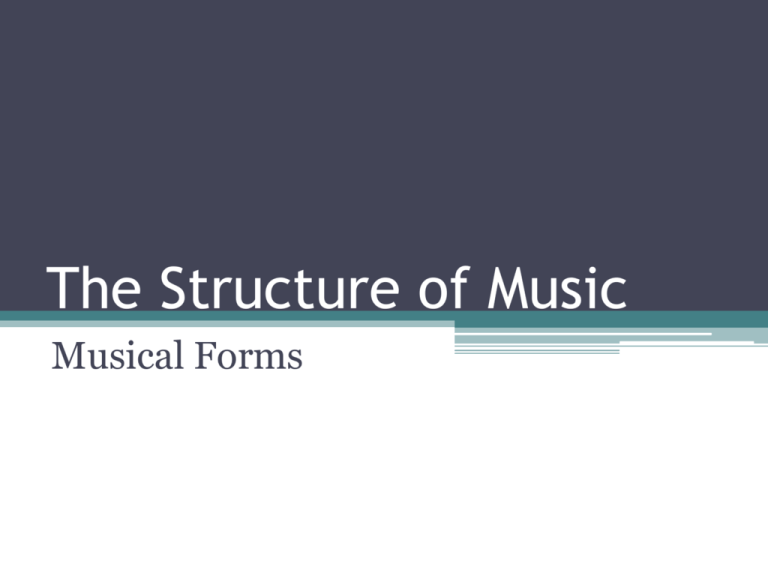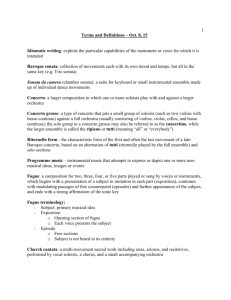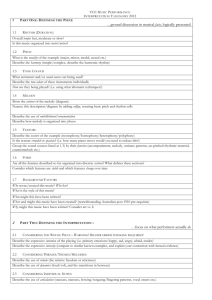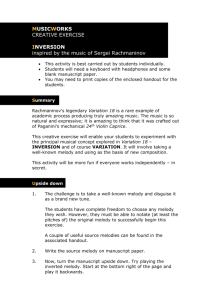The Structure of Music
advertisement

The Structure of Music Musical Forms Identification • Repetition and Contrast: major parts of form • Divide music into its major sections ▫ Music tends to be in 4 bar phrases ▫ Or multiples of 4: 8,12,16… • Utilize letters to identify sections ▫ ▫ ▫ ▫ A for the first section New material = new letter (B, C, D…) If there isn’t new material then A again Or if A is changed it is A’ Simple Musical Forms • Strophic • Binary • Ternary • Arch Strophic Form • • • • Letter Form: AAA Same music each verse (melody) Different words for each verse (strophe) Example: ▫ “Amazing Grace” and other hymns Binary Form • • • • • Letter Form: AB or AABB Melody is introduced in first section (maybe 2x) Then new material for the second section Song ends after “B” section Example: ▫ “Appalachian Spring” by Aaron Copland ▫ Arrangement from the production Blast! Ternary Form • • • • • Letter Form: ABA or AABA Melody is introduced in first section New material in second section Return to original melody in third section Example ▫ “Loss” from the production Blast! Arch Form • Letter Form: ABCBA or ABCDEFEDCBA • Melodies are new for each section • After middle section of the piece, move backwards through the sections (each section is still played forwards) • Example: ▫ “Land of Make Believe” by Chuck Mangione ▫ Arrangement from the production Blast! Complex Forms • • • • Theme and Variations Rondo Fugue Sonata Theme and Variations Form • Letter Form: AA’A”A’”… • Basic Melody stays, but each repetition becomes more complex • Example ▫ “Bolero” by Maurice Ravel ▫ Arrangement from the production Blast! Rondo Form • Letter Form: ABACADA… • First melody (section) is repeated between each new section • Main melody: Refrain • New material between: Episodes • Example ▫ “Trumpet Concerto” by Franz Joseph Haydn ▫ Tina Helseth: Trumpet & Norwegian Chamber Orchestra Fugue Form • • • • Polyphonic song based on a melody Subject: Tonic Answer: Dominant Countersubject: accompany the subject with a different melody Fugue Form • Episodes: transitions between statements, may contain parts of subject. • Pedal point: A single note held while voices work around it Fugue Form (cont.) • Example ▫ (a surprise) by Vincenzo Culotta ▫ “Theme from Bad Romance” by Lady Gaga Sonata Form • A single movement. Three sections: • Exposition (themes stated): A bridge/transition B (new key) • Development (themes changed): A’ and B’, fragmented, new keys, tension builds • Recapitulation (themes return): A bridge/transition B (all tonic) ▫ Sometimes a Coda is added to state the themes one more time. Sonata Form (cont.) • Example ▫ “Symphony No. 5, First Movement” by Ludwig Von Beethoven ▫ Arrangement from Disney’s Fantasia 2000 Jazz Music Form: The Blues • Most common form, the foundation of Jazz music and early Rhythm & Blues • Usually 12 bars long with a specific chord progression, but can be 8, 16 or 20 • I,I,I,I IV,IV,I,I V,IV,I,I • Example ▫ “Everybody Loves the Blues” from Blast! ▫ “Johnny B Goode” by Chuck Berry Review • • • • • • Strophic Binary Ternary Arch Theme and Variations Rondo • • • • • • AAA… AB or AABB ABA or AABA ABCDCBA AA’A”A’”… ABACADA Review (cont.) • Fugue: 5 parts of a fugue? ▫ Subject, Answer, Countersubject, Episodes, Pedal Point • Sonata: 3 parts of a sonata ▫ Exposition, Development, Recapitulation • The Blues: How many bars? ▫ At least 8 bars, 12 or 16 more common ▫ What is the chord progression? ▫ I,I,I,I IV,IV,I,I, V,IV,I,I




